Our current economic malaise was forecast and has been explained by only one “school” of economic theory: the Austrian.
One other “mainstream” school–the Keynesian Model–continues to fumble around with empirical data in a quest to venture 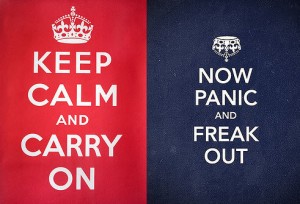 conjecture constantly refuted by that pesky little thing called “history.” The Keynesians, each to each, may vary in their opinions on government size and the amount of monetary inflation; however, they are lock-stepping, hand-in-hand, on a quest for that ever elusive mathematical model. It’s a thought experiment confined in a hermetically-sealed “statist” box. They’ve abandoned their logic for faith in bizarre assumptions.
conjecture constantly refuted by that pesky little thing called “history.” The Keynesians, each to each, may vary in their opinions on government size and the amount of monetary inflation; however, they are lock-stepping, hand-in-hand, on a quest for that ever elusive mathematical model. It’s a thought experiment confined in a hermetically-sealed “statist” box. They’ve abandoned their logic for faith in bizarre assumptions.
Austrian Economic Theory was founded on an understanding that the human ability to act combined with the natural desire to survive leads to a purposeful action. Humans act with purpose! Meddling in the affairs of folks acting towards a purpose only gums-up the purpose and the very folks trying to act on it. Interlopers butting in between other people who have agreed to cooperate for their mutual benefit are obstructionists at best and deal killers at worse. There may be compromises as individuals adapt to the force of those interventions allowing for diminished satisfaction, but the end results are inevitably spoiled. The Keynesian Cultists see humans as guinea pigs to be experimented on.
Economic theory is just like any other type of theoretical study in that the discipline must be dominated by academics. But here is the rub: Academia is not real life; it can’t be, shouldn’t be and never will be. Sure, it can foster clear thinking and should promote the realization of intellectual potential; however, do not allow the mysticism associated with “halls of higher learning”–going back to the pointy hats with stars on them–put a spell on you. Most Austrian School academics understand more clearly than their counterparts that the real world is what counts, and not the fantasy world of Hogwarts Institute of Pecuniary Magic.
The glaring difference between statist economic theorists and free-market economic theorists is this: mathematical models. Free-market Austrians rely on logical arguments stemming from human action. This point of view recognizes that the study of economics is more of a philosophical discipline than a scientific one. The Keynesians believe the exact opposite. This line of thinking seeks to put the study of economics in the realm of physical scientific disciplines–this is fallacy which damns its adherents to an eternity in purgatory. Why? Because economics is about human relationships, not numerical relationships. Real science requires the use of the scientific method and reproducible results. Don’t get me wrong, I am a believer in the scientific method…as it relates to “real” science and not “social” science.
http://www.youtube.com/user/PeterSchiffChannel?blend=21&ob=5
AUSTRIAN SCHOOL ECONOMISTS, in the simplest way I can describe, believe in free markets and avoiding government intervention–which, they argue, creates more problems than it solves. To them, Central Banks encourage excessive growth of credit by keeping 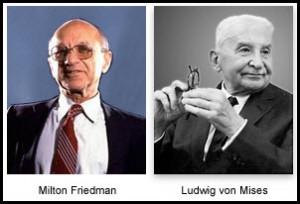 interest rates too low for too long: Ludwig von Mises and Friedrich Hayek predicted the depression of 1929; Peter Schiff, Robert Wenzel, Ron Paul, and a slew of others predicted the Housing Bubble burst of 2008. And the predictions keep rolling in because the government continues to intervene. You see, ask any Austrian Economist, and he will tell you: “The government can certainly cause a recession, but the government can’t proactively overcome one.”
interest rates too low for too long: Ludwig von Mises and Friedrich Hayek predicted the depression of 1929; Peter Schiff, Robert Wenzel, Ron Paul, and a slew of others predicted the Housing Bubble burst of 2008. And the predictions keep rolling in because the government continues to intervene. You see, ask any Austrian Economist, and he will tell you: “The government can certainly cause a recession, but the government can’t proactively overcome one.”
Of course, they are highly critical when it concerns the use of fiat money, since it enables governments to devalue exchange rates and destroy savings through inflation; this goes right along with their mutual excoriating of the Central Banks, who likewise cause inflation by merely printing money when it is needed, never mind the dangerous and “criminal” practice of fractional reserves. The Gold Standard is preferable. Even Lawrence H. White, an Austrian School Economists, in spite of some nifty ideas he has put forth with regards to how we could make a fiat system work…concludes that the Gold Standard is best.
Statistical econometric models are of relatively no use to them, as they prefer an emphasis on logical deductions derived from “observations” of “human behavior.” As such, they promote the civil liberties of free markets and the control of money supply in a way that promotes civil liberty and social progress.
http://www.youtube.com/watch?v=KWdUIuID8ag
Austrian economics is our most credible and reliable economic theory for the present day. If adopted, these ideas would put America back on the right track to re-establishing liberty in economics. We could expect to see recovery, growth, and progress in the private sector which will drive up the standard of living for the poor, middle, and upper-class. Class warfare can no longer persist if we wish to remain free. Foreign wars can no longer persist if we wish to remain free. Government intervention by the Federal Reserve can no longer exist in its current capacity if the United States of America chooses liberty above economic slavery and equality. My hope is that your consciousness is raised whenever you hear mainstream catch-phrases, and that you think of the Austrian method in response to popular economic ideas that spending will save our economy.
KEYNESIAN ECONOMICS? How about this….
http://www.youtube.com/watch?v=t_LWQQrpSc4
For Keynesians, the solution to a depression or recession is to stimulate the economy by cutting interest rates and investing in infrastructure. This injection of income would result in more spending in the general economy, stimulating further production and investment, creating a cascade of economic benefit. The most prominent example of Keynesian theory being put into practice is US 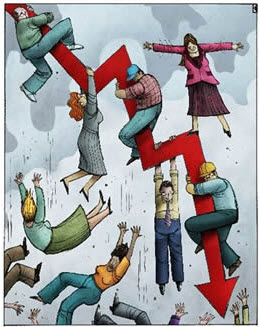 President Franklin D Roosevelt’s New Deal program, which supposedly revived the American economy in the 1930s. But, I beg to differ.
President Franklin D Roosevelt’s New Deal program, which supposedly revived the American economy in the 1930s. But, I beg to differ.
For a period of 18-months, from 1920 to 1921, the United States suffered a deep depression (Milton Friedman would later identify Federal Reserve policy as the source of this depression). President Warren Harding took action with rapid government downsizing…and in came the Roaring-Twenties.
The economy shot up like a rocket…and then dropped like a stick when the Federal Reserve intervened in ways that I haven’t the time nor inclination to cover here. Franklin Delano Roosevelt ushered in his New Deal—which brought us the Social Security Act, the Emergency Banking Act, the Securities and Exchange Commission, the Civilian Conservation Corps, the Agricultural Adjustment Act, the Fair Labor Standards Act, the Civil Works Administration, the Indian Reorganization Act, the National Industrial Recovery Act, the Public Works Association, the Homeowners Loan Corporation, the Tennessee Valley Authority, the Works Progress Administration, the Office of War Information & Bureau of Motion Pictures, the War Production Board, The National Labor Relations Act, the Farm Security Administration, the Federal Emergency Relief Administration…and the Federal Communications Commission. Keynesian Economics in all its inglorious shadings. How did it work? Let’s just say that the slump continued for approximately 10-years, until we entered WWII. The unemployment rate was essentially unaffected.
http://www.youtube.com/watch?v=btRWU_Q50QA
The Keynesian Pre-School adherents preach the gospel of central planning, which is why central planners/politicians subsidize their “work.” Their argument stems from the fact that the free market does not always result in maximum satisfaction of needs and desires. No shit, Sherlock! That “welcome to the real world” insight is easily dealt with by most working individuals coping with survival on a daily basis, but for some reason, the calculus of this condition cries out for correction by self-styled supernatural beings with 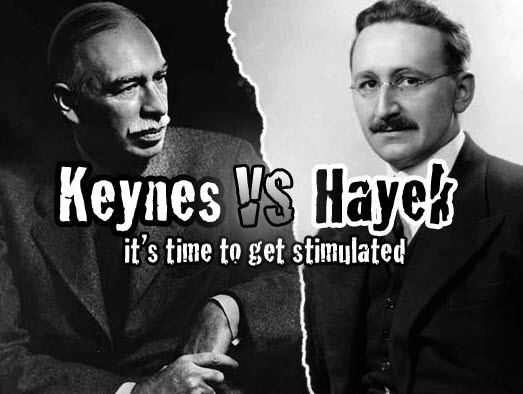 obviously too much time on their hands. If only all of us working saps would just follow the plans put forth by our masters then we would all be happy cogs in a well-oiled machine humming along at maximum efficiency! Of course, it doesn’t take very long until the standard of perfect harmony that the free market was held up to is abandoned when judging the results of central planners.
obviously too much time on their hands. If only all of us working saps would just follow the plans put forth by our masters then we would all be happy cogs in a well-oiled machine humming along at maximum efficiency! Of course, it doesn’t take very long until the standard of perfect harmony that the free market was held up to is abandoned when judging the results of central planners.
Let’s see Hayek and Keynes duke it out!
http://www.youtube.com/watch?v=d0nERTFo-Sk
And…..
http://www.youtube.com/watch?v=GTQnarzmTOc&feature=relmfu
Fear and populism can kill us where money is concerned. And, if you are still confused about the differences between the Keynesian and Austrian schools of economics, may I humbly propose an analogy that may help your understanding:
In the early 1900s, citizens were freaking out at the sight of burning trees nearby; as well, the local lumber companies were watching prospective profits going up in smoke. So, the US Forest Service devised a plan to aggressively suppress any and all forest fires. They looked at statistics, they identified what they saw as patterns, they obtained equipment, trained men, and worked out elaborate schemes to “fix“ the problem. And, by exhausting a lot of time, effort and money, they reduced fire damage considerably…for the time being. You see, without periodic fires of a “small” kind, the undergrowth in these forests became thick; therefore, it was more susceptible to ignition which would in turn act as additional fuel and make the fires even hotter…and larger…sending the flames up and into the crowns of mature trees, spreading faster and farther…killing off much larger portions of the forest.
During their initial planning stages of fire prevention, the bureaucrats of the US Forest Preserve didn’t take some things into consideration: the occasion of periodic and “small” fires cleared the undergrowth and burned the deadwood; the fires were less ignitable, less hot, less damaging, and rarely (if ever) reached the crowns of mature trees; in fact, these “small” fires cleared the way for an environment that triggered tree seeds to sprout, to start a healthy new generation; even the mature trees grew better, and healthier; and, after even further consideration, the Forest Preserve macro-environmentalists shredded the old plan and backed away, allowing the natural cycle of nature to return.
I wish the same could be said of the Keynesian Macro-economists.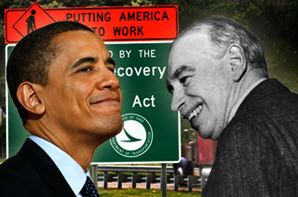
Keynesian School followers (Paul Krugman, Ben Bernanke, Lawrence Summers, Michael Woodford, etc…) believe that all recessions are bad and must be suppressed by government intervention–utilizing elaborate and costly methods for the sake of benefiting the public as a whole…deadwood, undergrowth, and all…
Austrian School followers (Peter Schiff, Murray Rothbard, Peter Boettke, Larry White, etc…) understand that when markets veer from reality, they must be purged by an occasional adversity, ridding the arena of failing or obsolete enterprises so that capital is not wasted, so that new and innovative businesses can emerge to create a more productive and prosperous society….Periodic small recessions or “fires” are necessary if and economy is to remain healthy.
http://www.youtube.com/watch?v=MnekzRuu8wo
Based on the above video, which “school” do you trust????




